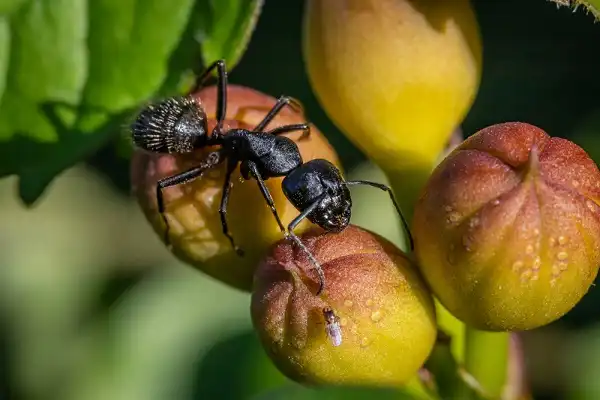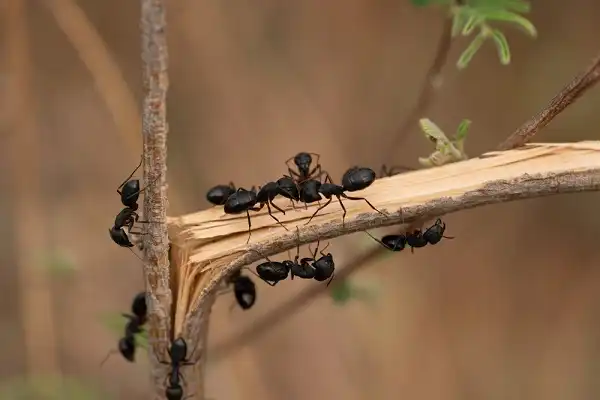Although small in size, carpenter ants can wreak havoc on your home if they’re not removed quickly. These insects are attracted to moisture, so you’ll often find them near leaky pipes or windows. If you have carpenter ants in your home, it’s important to call a professional exterminator immediately. Continue reading to learn more about these pests and how to get rid of them.

Carpenter Ant Description
Carpenter ants are a species of ant that has the ability to chew into wood and hollow it out. This can cause extensive damage to furniture and buildings, so they must be dealt with quickly. While they do not actually eat wood, they use it to make galleries and tunnels for nesting, raising their young, storing food, and traveling through. Depending on the species they may be black, brown, red, or yellow but typically possess a combination of these colors. Their heads are rounded with large eyes located close together at the front while their thoraxes are slender and elongated. These ants often inhabit dead or decaying wood, but will also enter living trees or wooden structures such as houses and decks. They prefer humid places so you may find them near leaky pipes or windowsills that accumulate moisture. Carpenter ants can also be found near other sources of water such as air conditioners and swimming pools.
Carpenter Ant Habitat
Carpenter ants are most commonly found in North America, living in both urban and rural areas. They prefer humid environments and typically nest inside wood or trees that have been exposed to moisture or decay. While they can occasionally be seen outdoors, they will usually establish their colonies indoors where there is a steady supply of food and water. Carpenter ants tend to set up their nests in areas with softwood like pine, spruce, cedar, fir, and hemlock. They prefer these kinds of woods because they are easier to excavate tunnels within. In homes or buildings, carpenter ants are often attracted to leaky pipes or windowsills where moisture accumulates; however, they can also be found near other sources of water such as air conditioners and swimming pools. These creatures may travel up to several hundred yards away from their nest in search of food; thus it is important to eliminate any possible food sources near your residence if you want to avoid a carpenter ant infestation.
Carpenter Ant Diet
Carpenter ants are omnivorous insects and have varied diets. They feed on a variety of other insects, honeydew from aphids, nectar, pollen, fruits, and even small vertebrates such as lizards and birds. Outdoors, and carpenter ants primarily feed on other insects such as flies, caterpillars, and beetles. In addition to these prey items, they will also scavenge for plant materials such as sugars in the sap of trees or fruit that has fallen from nearby trees. Inside homes and buildings, carpenter ants may feed on various sweets including syrup or honey, sugary drinks like soda or juice, candy or chocolate bars as well as any other sweet items that can be found lying around the house. While adults typically feed on these food sources, larvae are more likely to consume proteins from insect prey that adults bring back to their nesting sites. Foraging trips can take the ants up to several hundred yards away from their nests in search of food sources. To prevent an infestation it is important to eliminate possible food sources near your residence; this includes anything sweet like spilled sugary drinks or candy bars as well as potential insect prey like bird’s nests and garden pests. Additionally, regular cleaning of kitchens and pantries is also recommended in order to remove any crumbs or spills which could attract carpenter ants.

Carpenter Ant Size
Carpenter ants are an incredibly diverse species whose size can vary greatly depending on their gender, subspecies, and age. Adult carpenter ants range from one-eighth of an inch to up to one-half of an inch in length; queens however, can reach up to five-eighths of an inch in length. The size of a carpenter ant is determined by its caste system; worker ants are generally smaller than soldiers and queens who have different roles in the colony. Worker ants make up the majority of a nest and measure between 3 to 12 millimeters in length while soldier ants measure up to fifteen millimeters with larger mandibles adapted for defense against predators. Queens tend to be the largest members within a nest measuring up to 18 millimeters long with larger abdomens that enable them to lay eggs for new generations of worker and soldier ants.
Carpenter Ant Lifespan
The average lifespan of a carpenter ant depends on the species and its role within the colony. Worker ants typically live for around 1 to 2 years, while soldier ants can live for up to 3 years. Queens have the longest lifespan; some species of queen carpenter ants can live for up to 10 years or more! Carpenter ants may be endangered by natural predators such as spiders or birds, but the most common cause of death is due to old age. As they get older, worker and soldier ants will become weaker and less able to perform their duties. Additionally, they may also become more vulnerable to disease and parasites which can weaken their immune systems over time. Eventually, the oldest members of a colony will die off naturally as new generations are born. Carpenter ants play a very important role in maintaining forest health by controlling pest populations that would otherwise damage trees or plants; however, due to their short lifespans, it is important that colonies continue reproducing enough larvae in order to sustain their populations each year so they can continue performing this vital ecological service on our planet.
Carpenter Ant Behavior
Carpenter ants are active creatures and display a wide range of interesting behaviors throughout their colonies. Worker ants are responsible for gathering food, tending to larvae, digging out new tunnels or galleries, defending against predators, and maintaining the overall hygiene of the nest. These activities involve several different communication methods such as chemical signals, vibrations, and pheromones that allow them to relay important information across the colony such as danger warnings or where to find food sources. Soldier ants also play an important role in keeping their colonies safe by patrolling around their nests and engaging in aggressive behavior when threatened. If they encounter potential threats they will bite or sting intruders while alerting other workers with chemical signals so that the entire colony can mobilize in defense. They can also defend against larger threats like rodents or other insects by using their large heads and powerful mandibles to push them away from the nest. In addition to defensive tactics, carpenter ants also use their formidable jaws for more constructive tasks like excavating galleries within wood structures.

Carpenter Ant Speed
Carpenter ants are well known for their remarkable speed and agility, able to traverse distances of up to 10 meters in a matter of seconds. In addition to their incredible running speed, carpenter ants are also able to fly short distances with great accuracy and control. This allows them to quickly travel from one tree branch or branch tip to another without having to scale down the trunk. Carpenter ants possess powerful legs which help them cover ground quickly. Their legs are designed in such a way that they can move in any direction for maximum maneuverability when navigating complex terrain. They have specially adapted claws that allow them to grip onto surfaces firmly and make sharp turns at high speeds. The speed of carpenter ants is further enhanced by their impressive strength and agility; they are capable of carrying objects up to 50 times their body weight while maintaining their top speeds. This makes them ideal for gathering food sources from faraway locations or transporting materials around the nest with little effort. The cognitive ability of carpenter ants also contributes greatly towards their speed; these insects are capable of learning patterns and memorizing shortcuts that allow them to make efficient use of their time when traveling around the colony or exploring new areas.
Carpenter Ant Hunting
Carpenter ants are incredibly adept hunters, able to track down and capture prey with remarkable speed and accuracy. This is due to their impressive olfactory glands which allow them to detect scents up to 100 feet away. They also have large mandibles that allow them to clamp down on prey with considerable force, as well as longer antennae that provide additional sensory data when stalking their quarry. When a carpenter ant is hunting, it will first use its senses of smell and sight to locate potential food sources. It will often explore the area in circles or zig-zag patterns in order to quickly cover more ground and find any hidden sources of nourishment. Once it finds an object of interest, the carpenter ant will then release pheromones that alert nearby ants of its discovery so they can join in on the hunt if necessary. Overall, carpenter ants display an incredible level of intelligence and skill when it comes time for hunting – traits that make them a formidable species within the animal kingdom! Their keen sense of smell combined with their extraordinary strength makes them more than capable of successfully capturing unsuspecting prey no matter how small or hard-to-reach they may be!

Conclusion
In conclusion, carpenter ants are incredibly fast and efficient insects that can traverse great distances quickly and accurately. They possess impressive cognitive abilities, allowing them to learn patterns and remember shortcuts which make exploring new environments less time-consuming. Furthermore, they are highly skilled hunters with a keen sense of smell as well as powerful mandibles capable of subduing prey with ease. Overall, carpenter ants serve as an inspiring example of the amazing things that nature can achieve when given the opportunity! Carpenter ants are remarkable creatures that prove just how much potential there is in even the smallest organisms when it comes to adaptation and evolution.
Frequently Asked Question

